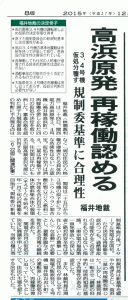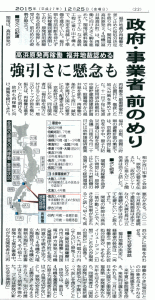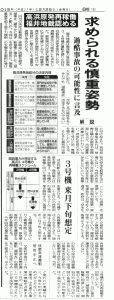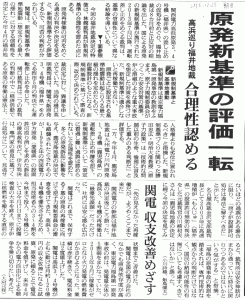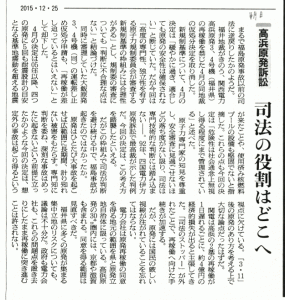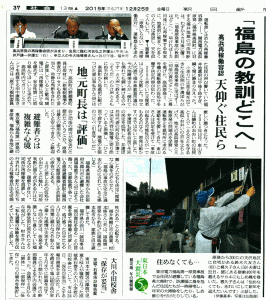Original Japanese written by staffer
The English below translated from the original Japanese by Heeday
The English translation edited by Rev. Dr. Henry French, ELCA
(Based on articles from the December 25th, 2015 editions of the Fukushima Minpo, Asahi Shimbun, and Akahata newspapers)
▲Click each image to enlarge. We are sorry we have yet to provide English summaries of the newspaper articles below.
On December 24th, 2015, the Fukui District Court overturned its own provisional ruling of April 2015 (※) which prohibited the restart of Units 3 and 4 of the Takahama Nuclear Power Plant (NPP), and gave a go-ahead to the restart, claiming that “the new regulatory safety standard and the examination results are reasonable and no specific danger is seen to the lives of neighborhood residents.”
[(※) Judge Hideaki Higuchi, who served the District Court then, in effect denounced the new safety standard, pointing out that there is a danger of ground motion beyond just the earthquake caused motion assumed by the Kansai Electric Power Co. Inc. which could lead to a severe accident at the NPP. Thus, the Judge suspended the restart. In response to this, Kansai Electric filed an objection to the District Court.]
Also, the Court’s Chief Judge Hayashi on December 24th overturned the provisional ruling, made by then Chief Judge Hideaki Higuchi, which suspended the restart of Units 3 and 4 of Kansai Electric’s Oi NPP (Ohi Town [pronounced “oh-e”], Fukui Pref.).
Takahama’s Units 3 and 4 passed the Nuclear Regulation Authority’s restart examinations in February 2015, following the Sendai NPP of Kagoshima Prefecture. Also, Fukui Prefecture’s Governor Nishikawa gave consent to the restart. Furthermore, the relevant local authorities have consented. Thus, the December rulings by the District Court now enable Kansai Electric to place nuclear fuel in Unit 3 and have it inspected, along with making other preparations for the restart. The power company plans to restart Unit 3 in January 2016. Meanwhile, many neighborhood residents are dissatisfied with the court rulings and plan to file an appeal to the Kanazawa Branch of Nagoya High Court.
Kansai Electric has the greatest dependence on nuclear power among all the existing power companies in Japan. Prior to the meltdown of TEPCO’s Fukushima Daiichi, almost 50% of Kansai Electric’s power came from NPPs. Since the nation’s electricity became temporarily free of nuclear power in September 2013, Kansai’s business has been in the red. The power company has raised its power rates twice since then. The company estimates that with both Units 3 and 4 at work at Takahama, its financial balance should improve by some 12 billion yen monthly. The power company plans to cut its rates to survive the coming deregulation of Japan’s power market that begins in April 2016.
Since the Fukushima Daiichi meltdown, there have been many court appeals to prohibit NPP restarts all over the nation.
In Japan, there have been court cases over nuclear power since the early 1960s. Plaintiff citizens won at a District Court in the cases of “Monju”—a fast breeder reactor in Fukui Prefecture—and Hokuriku Electric Power’s Shika NPP, in Ishikawa Prefecture.
Those District Court decisions, however, were all overturned by the Supreme Court or a High Court. Thus, judicial decisions that “no specific danger is recognized” have become commonplace.
Later, following the Fukushima Daiichi disaster, there developed a movement to question NPPs’ safety with new anti-nuclear teams of attorneys formed nationwide. So far, some 30 provisional rulings and class actions have emerged, according to sources.
In May 2014, in one of those class actions, the Fukui District Court gave an order that Units 3 and 4 of the Oi NPP, Fukui Prefecture, must not be restarted. The same Chief Judge in April 2015 issued a decision that Units 3 and 4 of Takahama must not be restarted either. Almost a week later, however, the Kagoshima District Court turned down plaintiff residents’ petition for a provisional ruling to ban the restart of Units 1 and 2 of the Sendai NPP.
Ex-Judge Kazuo Kawasaki, who served the Kanazawa Branch of Nagoya High Court as Chief Judge, issued a decision in 2003 that annulled the installation permission for the “Monju” fast breeder reactor (Fukui Pref.) Said the ex-judge, “Watching the court decisions at Kagoshima District and Fukui District, I feel like courts are going back to the age when the nuclear safety myth was commonly believed.” He also said, “Learning lessons from the Fukushima disaster, I think judges need to consider not just technical aspects, but whether or not the majority of the people are convinced by court decisions about nuclear power as well.”
In the coming years, the courts of Japan are expected to give provisional rulings and decisions over NPP restarts, and many fear that the Fukui District’s decision might provide a bad model for other courts to follow.
Many courts here seem oblivious to the Fukushima tragedy. We must not allow nuclear power to hurt and victimize another person. Each and every one of us, therefore, needs to keep Fukushima firmly in his/her mind and communicate the consequences of the disaster to the coming generations.

